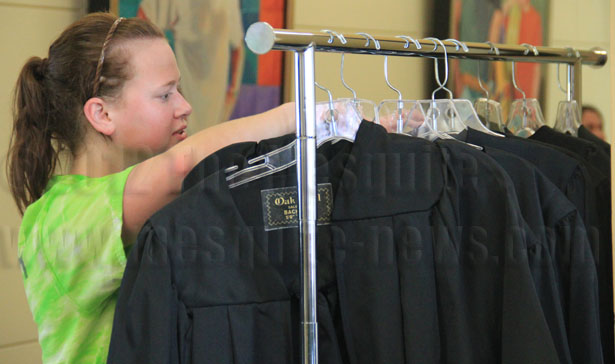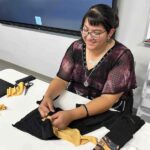
By Lucia Espino
Community outreach and networking with local businesses, including Toyota, are giving campus administrators a first look at high-demand jobs and future positions nationwide.
In a recent interview in her office, President Maria Hernandez Ferrier said the university’s emphasis on jobs after graduation is expected to provide students an up-to-date education and “first shot” at better paid positions.
Ferrier’s comment comes on the heels of the 84th annual gala of the San Antonio Hispanic Chamber of Commerce (SAHCC), where it was announced that higher education and skills training for unemployed and underemployed citizens are a high priority.
Alexander Briseño, the chamber’s newly appointed chairman and public service professor for St. Mary’s University, said the chamber is encouraging the improvement of academic training in science, technology, engineering and mathematics (STEM) careers.
Among six representatives from the university who attended the gala, Eric Lopez, head of School of Education and Kinesiology, said that the university is very involved with SAHCC’s education committee.
Specifically, the university is part of the chamber’s STEM initiative.
Lopez said that one program, the Toyota Texas Teacher STEM scholarship, aims to place students in a teaching position related to the STEM program.
He said there are four $27,000 scholarships and one will be awarded every spring semester to a high school graduate.
The student applying must be from East Central, Harlandale, Somerset, Southside, Southwest or South San Antonio school districts.
The recipient must attend Palo Alto College upon graduation and finish a STEM teaching education degree at A&M-San Antonio.
Once certified as STEM teachers, scholarship graduates will return to teach at the schools they once attended, Lopez said.
Last year, Katie Drsymala, East Central High School graduate, received the scholarship.
Briseño said that education centers like Café College have helped students find the resources needed to begin college, thus increasing the city’s higher education enrollment.
In agreement, Ferrier expressed the importance and need for STEM education.
Classrooms and society have changed dramatically when it comes down to technology, and STEM-focused classes at high schools and middle schools are not enough anymore — soon they will be introduced at Pre-K level, Ferrier said.
“My grandchildren know more about computers than I do, because they were born with it,” she said. This will also increase the demand for teachers who are skilled in these fields, she continued. “The A&M System graduates the most teachers of any other system in the state of Texas … It is critically important that the teachers that we graduate are really prepared.”
Ferrier noted one of her first contributions to the university was to call upon school district superintendents to inspect each respective curriculum and look for what was missing or needed strengthening.
Velma Villegas, employed with the university as a special assistant for education and teaching, was one of the local superintendents from the Southwest Independent School District, who revised the curriculum after finding out that teachers lacked elementary mathematical skills.
Elementary teachers know math in general, Ferrier said, but they didn’t really get a solid foundation in math and this subject is essential for any STEM career.
After realizing this, Ferrier and Dan Jones, president of Texas A&M University-Commerce, led the P-20 initiative for the Texas A&M System to help create a framework for the preparation of highly effective teachers graduating from the system.
“STEM is not something new, but we are really realizing how important it is when you start at a younger age,” she continued.
At the gala, Briseño announced that SAHCC is creating a Workforce Capacity Building Taskforce to help underskilled workers who can take advantage of a more successful job.
The program will provide workers with “life changing career opportunities,” he said, emphasizing that better prepared workers mean more outside businesses investing in the city.
According to Briseño, it will take a minimum of five years to see the results of the STEM program, something Ferrier does not agree with.
“We are already seeing a turnaround in middle schools and high schools involved in STEM…with the interventions we are doing right now, we are going to see the results much sooner,” Ferrier said.
She listed interventions like the $10,000 affordable degree which targets high school students interested in STEM careers.
Ferrier said students can graduate high school with 60 credit hours, take 28 at the Alamo Colleges and finish the last 36 at A&M-San Antonio, earning a Bachelor of Applied Arts & Sciences (B.A.A.S.) with an emphasis on Information Technology degree.
Non-STEM majors also benefit from the partnership with the chamber by receiving network opportunities with businesses who are not STEM related, she said.
The university is also a member of the Greater San Antonio Chamber, San Antonio Women’s Chamber, West San Antonio Chamber and South San Antonio Chamber. The university was listed as a non-profit gala sponsor at the 84th annual gala of the San Antonio Hispanic Chamber of Commerce.
Ferrier will be meeting with Briseño in the next couple of weeks to discuss the chamber’s new initiatives. She said the chamber has held meetings at Main Campus in the past.
Because of the fast growing rate of Hispanics and the location of the university, being part of this chamber is essential, Ferrier said.
“I think the Hispanic chamber is a very important chamber… 50 years down the road we (Hispanics) are going to be the majority, so it’s really important,” Ferrier said.





